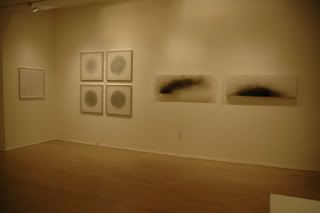SUNGMI LEE: Evanescence
October 3 – October 27, 2007
C. Grimaldis Gallery
523 North Charles Street
Baltimore, MD 21201
Tuesday – Saturday, 10am – 5:30pm
www.cgrimaldisgallery.com
In John Keats poem, “Ode to a Grecian Urn,” he muses: ‘Heard melodies are sweet, but those unheard are sweeter.’ When something vanishes, we get a haunting sense of a lingering reaction. In memory we look inside ourselves for the answer and an imperative searching is inquired of our emotions. It brings us up close to the world or, in the case of Sungmi Lee’s new works at the C. Grimaldis Gallery, a steady eye and . . . a nose.
At first sight I thought Sungmi Lee’s works were large-scale photographs. The trouble begins when there is a more profound finding; they are, in fact,drawings. And the surprising thing about her drawings is that they are not made by the artist’s hand, rather, by the scribbling hand of nature.
Lee’s drawings are executed with burning incense on the back of a sheet of Plexiglas. The drawing is then enclosed in a wide plexi box and hung on the wall. Her work seen through plexi is magnified. In this manner, each Zen drawing’s swirls are described by smoke a little more precisely. Though explosive, Lee’s imagery is not for the restless eye eager to take everything in but, conversely, each one begs to be read mindfully. Reading their activity requires a considerable amount of restraint while the enclosure encourages us to go further into that world, evoking deep inward thought. Their terrarium-like enclosures are perhaps an intended setting for purging of distraction. Each pulls us into the experience tightly focused on a single event, a time or memory. You feel the reality of each piece through magnification or sharpness of looking through glass, and not removed by it. It brought my nose right to its seams. Though I could not get any scent, they are terrariums that hold what I’m hoping is a “terrior” or flavor of the land.
Lee is especially sensitive to the ways in which her chosen medium works, fleeting and evasive, wrestling with chance and the unknown—the imagination of it actually happening can be almost efficacious as the physical actuality. There is something evocative about it and elusive, like music heard in a dream. Still, we have a sense that there is more that remains— not hidden but unseen. Here the meticulous hand of nature, frenetic pacing at once and then languidly writing at the other, discerns lines of poetry. Our perception of emotional breadth then is layered, characterized by an ominous weather system or a slow-motion gunshot explosion.
The style of Lee’s drawings seem to emerge out of a different time, reminiscent of images taken in the 19th century and influenced by glass negatives. Because they are dark and lush, saturated with romanticism, these burned blotches or scribbles of smoke seem to erupt out of a blank atmosphere, obliterating the horizon. Sungmi’s stark white fields often call to mind a sense of loss. They seem to recall places from a forgotten past. This feeling is accentuated by the artist’s treatment of the image, washing out the contrast between light and dark, and using a soft focus that diminishes detail. The viewer is left struggling with his or her own means of perception, filling in the visual gaps and narrative with imagined scenarios as a hazy memory.
Lee’s drawings, like large-scale photographs, are similarly under the spell of long exposures. However it is also through their long exposure that they are so different than photographs because the viewer is physically able to discover time. Albeit slow, they have a visible velocity. In this manner they are less a record the way a photograph freezes a moment in time but more she is evoking the movement of vanishing memory. The memory, as smoke, is not given to us in a snapshot but rather revealed to us in a time continuum or a tableau allowing the accumulation of movement of time.
Is scent implied? Perhaps the memory of scent is sweeter. Lee’s images of memory disappear like vapor. Their activity gradually vanishes as I imagine the plate of veneer being pulled away to float each cloud of smoke. Sungmi Lee’s drawings offer a few hints to the riddle of her work. Captured in a glass her “evanescence” containers linger steady in the mind.
– Rob Sparrow Jones










